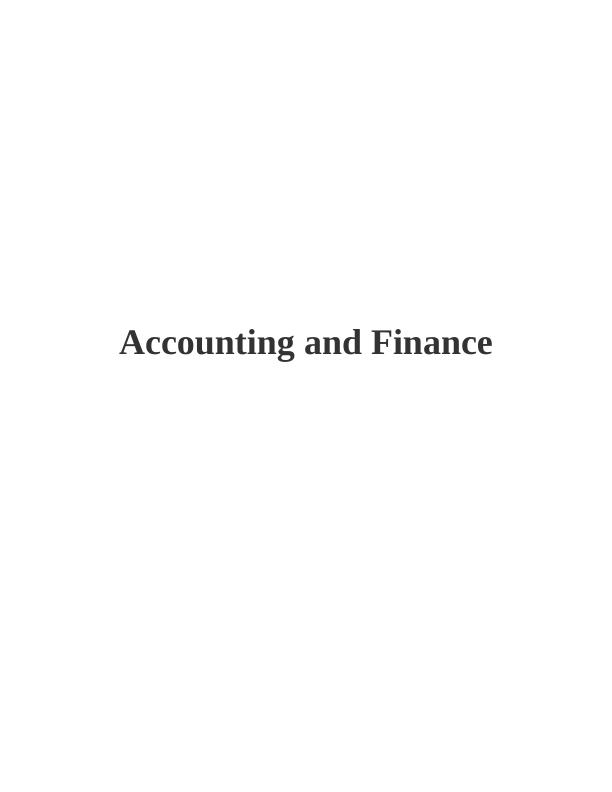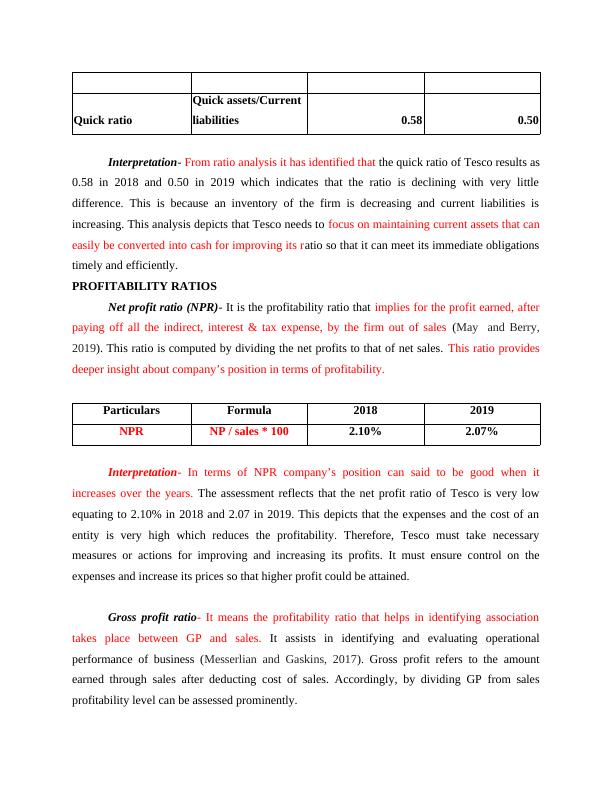Financial Analysis of Tesco: Liquidity, Profitability, Efficiency, and Leverage Ratios
Added on 2023-01-12
14 Pages2135 Words73 Views
Accounting and Finance

Table of Contents
INTRODUCTION...........................................................................................................................3
CONCLUSION................................................................................................................................9
REFERENCES..............................................................................................................................10
Appendix........................................................................................................................................11
INTRODUCTION...........................................................................................................................3
CONCLUSION................................................................................................................................9
REFERENCES..............................................................................................................................10
Appendix........................................................................................................................................11

INTRODUCTION
Accounting is referred as an art of recording & reporting business or monetary
transactions of the company. On the other hand, finance is managing the funds of the business in
an optimum and effective for getting desired level of outcome or success. For this report, Tesco
has been selected which operates as a large supermarket chain in UK. The report presents the
financial analysis of the company for two years by using ratio analysis as a tool for analysing its
performance.
LIQUIDITY RATIOS
Current ratio (CR)- It is the popular metric that assess the shirt term liquidity position of
the company in respect to available assets and outstanding liabilities (Murad and et.al., 2019).
This ratio reflects an ability of an enterprise in generating adequate cash in order to pay off all
the debts as it become due. It is measures of analysing the entire financial state of an
organization. By dividing liquid assets from current liabilities liquidity position of the firm can
be assessed effectually.
Particulars Formula 2018 2019
CR CA / CL 0.71 0.61
Interpretation- From the above table it has been represented that over the years the
current ratio of Tesco is seen as declining which means that current assets of the firm is reducing
with increase in the current liabilities. This shows that the liquidity position of the company is
affecting that in turn means that company is not using its current or short term assets in an
effective and efficient manner.
Quick ratio- It referred as the financial ratio which is used for analysing short term
liquidity position of an entity. It is also known as an acid test ratio which helps in assessing
company’s ability in relation to fulfilling current obligations from current assets excluding stock
and prepaid expenses (Gouda, El-Hoshy and Hassan, 2018).
Particulars Formula 2018 2019
Accounting is referred as an art of recording & reporting business or monetary
transactions of the company. On the other hand, finance is managing the funds of the business in
an optimum and effective for getting desired level of outcome or success. For this report, Tesco
has been selected which operates as a large supermarket chain in UK. The report presents the
financial analysis of the company for two years by using ratio analysis as a tool for analysing its
performance.
LIQUIDITY RATIOS
Current ratio (CR)- It is the popular metric that assess the shirt term liquidity position of
the company in respect to available assets and outstanding liabilities (Murad and et.al., 2019).
This ratio reflects an ability of an enterprise in generating adequate cash in order to pay off all
the debts as it become due. It is measures of analysing the entire financial state of an
organization. By dividing liquid assets from current liabilities liquidity position of the firm can
be assessed effectually.
Particulars Formula 2018 2019
CR CA / CL 0.71 0.61
Interpretation- From the above table it has been represented that over the years the
current ratio of Tesco is seen as declining which means that current assets of the firm is reducing
with increase in the current liabilities. This shows that the liquidity position of the company is
affecting that in turn means that company is not using its current or short term assets in an
effective and efficient manner.
Quick ratio- It referred as the financial ratio which is used for analysing short term
liquidity position of an entity. It is also known as an acid test ratio which helps in assessing
company’s ability in relation to fulfilling current obligations from current assets excluding stock
and prepaid expenses (Gouda, El-Hoshy and Hassan, 2018).
Particulars Formula 2018 2019

Quick ratio
Quick assets/Current
liabilities 0.58 0.50
Interpretation- From ratio analysis it has identified that the quick ratio of Tesco results as
0.58 in 2018 and 0.50 in 2019 which indicates that the ratio is declining with very little
difference. This is because an inventory of the firm is decreasing and current liabilities is
increasing. This analysis depicts that Tesco needs to focus on maintaining current assets that can
easily be converted into cash for improving its ratio so that it can meet its immediate obligations
timely and efficiently.
PROFITABILITY RATIOS
Net profit ratio (NPR)- It is the profitability ratio that implies for the profit earned, after
paying off all the indirect, interest & tax expense, by the firm out of sales (May and Berry,
2019). This ratio is computed by dividing the net profits to that of net sales. This ratio provides
deeper insight about company’s position in terms of profitability.
Particulars Formula 2018 2019
NPR NP / sales * 100 2.10% 2.07%
Interpretation- In terms of NPR company’s position can said to be good when it
increases over the years. The assessment reflects that the net profit ratio of Tesco is very low
equating to 2.10% in 2018 and 2.07 in 2019. This depicts that the expenses and the cost of an
entity is very high which reduces the profitability. Therefore, Tesco must take necessary
measures or actions for improving and increasing its profits. It must ensure control on the
expenses and increase its prices so that higher profit could be attained.
Gross profit ratio- It means the profitability ratio that helps in identifying association
takes place between GP and sales. It assists in identifying and evaluating operational
performance of business (Messerlian and Gaskins, 2017). Gross profit refers to the amount
earned through sales after deducting cost of sales. Accordingly, by dividing GP from sales
profitability level can be assessed prominently.
Quick assets/Current
liabilities 0.58 0.50
Interpretation- From ratio analysis it has identified that the quick ratio of Tesco results as
0.58 in 2018 and 0.50 in 2019 which indicates that the ratio is declining with very little
difference. This is because an inventory of the firm is decreasing and current liabilities is
increasing. This analysis depicts that Tesco needs to focus on maintaining current assets that can
easily be converted into cash for improving its ratio so that it can meet its immediate obligations
timely and efficiently.
PROFITABILITY RATIOS
Net profit ratio (NPR)- It is the profitability ratio that implies for the profit earned, after
paying off all the indirect, interest & tax expense, by the firm out of sales (May and Berry,
2019). This ratio is computed by dividing the net profits to that of net sales. This ratio provides
deeper insight about company’s position in terms of profitability.
Particulars Formula 2018 2019
NPR NP / sales * 100 2.10% 2.07%
Interpretation- In terms of NPR company’s position can said to be good when it
increases over the years. The assessment reflects that the net profit ratio of Tesco is very low
equating to 2.10% in 2018 and 2.07 in 2019. This depicts that the expenses and the cost of an
entity is very high which reduces the profitability. Therefore, Tesco must take necessary
measures or actions for improving and increasing its profits. It must ensure control on the
expenses and increase its prices so that higher profit could be attained.
Gross profit ratio- It means the profitability ratio that helps in identifying association
takes place between GP and sales. It assists in identifying and evaluating operational
performance of business (Messerlian and Gaskins, 2017). Gross profit refers to the amount
earned through sales after deducting cost of sales. Accordingly, by dividing GP from sales
profitability level can be assessed prominently.

End of preview
Want to access all the pages? Upload your documents or become a member.
Related Documents
Financial Management and Analysislg...
|21
|5214
|1
Accounting and Financing in Organizationlg...
|13
|1561
|72
Financial Performance Analysis of Tesco and Sainsburylg...
|22
|4069
|1
Financial and Economic Interpretation and Communication | Reportlg...
|8
|1350
|29
Financial Marketinglg...
|24
|3883
|42
Analyze the Performance and Accounts Assignmentlg...
|9
|1328
|38
